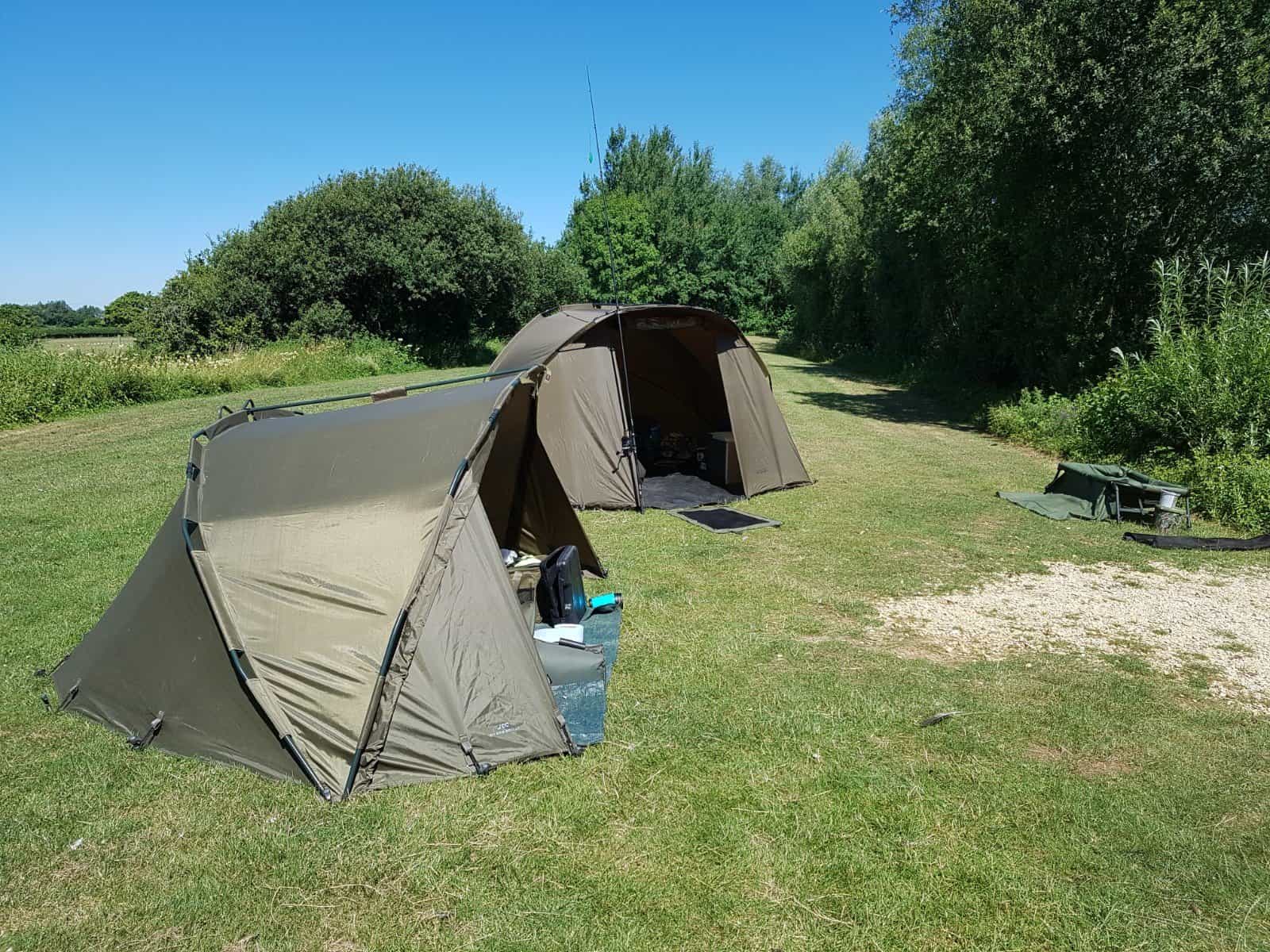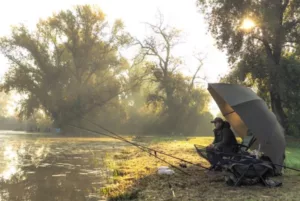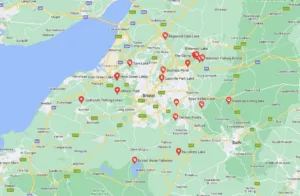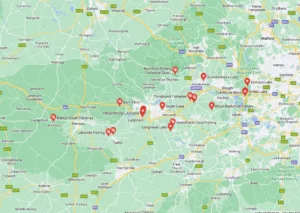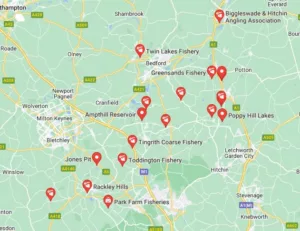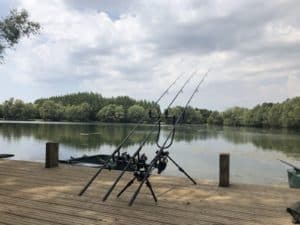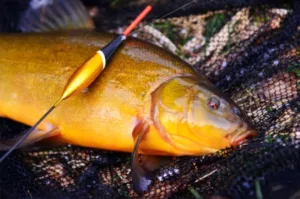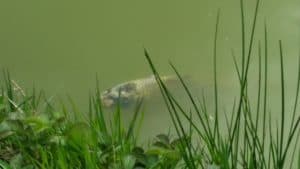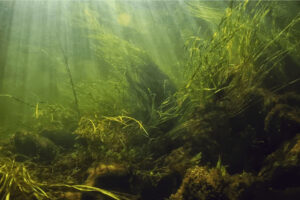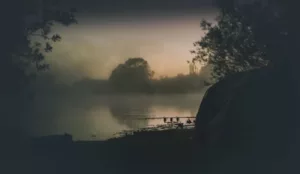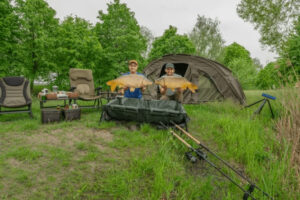Here are the best carp fishing tips aggregated from my experience of carp fishing and from other anglers I know.
I hope that at least one of these tips helps you to progress and catches you more fish!
Carp Fishing Tips for Beginners
1. Find The Fish Before Finding A Swim
This is the first tip for a reason. It is one of the fundamentals when it comes to taking fishing seriously. It is carp fishing 101.
Find the fish, rather than setting up in the first swim you see.
Put the time in to locate the carp first, even before the rods come out.
Even if it takes 3 hours to locate the fish. You could very easily waste ten hours at the wrong end of the lake and not catch anything if you don’t locate them first.
If you do spend 3 hours looking for them, you could catch one instantly, so make sure it is a priority to find them first.
2. Use Polarized Glasses
When looking for the fish, the glare from the water could be blinding you to was is swimming right in front of you.
Polarized glasses allow you to see through the top layers of the water. They will make it easier to spot the fish and easier to spot the swirls of mud that the fish might be creating.
They are very cheap but very effective in what they do.
3. Trickle Bait Rather Than All At Once
The old saying states, “once the bait is put in the lake, it can’t be taken out again”.
Be slow to throw the bait into the water, until you get to know the lake. Test with a small amount of bait and then gradually feed more and more as your session passes.
4. Get The Singles Out First
A lot of the big fish I have caught are caught because I have cast single baits out to showing fish.
Big fish have been known to work out that big beds of bait mean danger, so they skim around the edge of the baited area and pick up the single baits instead.
5. Stick To One Lake Per Season
By sticking to one lake per season rather than trying a different lake every time you go, you will start learning the patterns of the lake and figuring out what bait the fish like.
This will give you a huge edge over the other anglers that don’t spend enough time trying out different baits.
By learning the patterns, you will instinctively know exactly where the fish are likely to be according to the weather conditions for that day.
6. Use A Lake Map For Every Session
I use a lake map to mark down where I see fish, where the fish have been caught from, the wind direction and strength, bubblers, showing fish, where other anglers are fishing and casting, and where other anglers catch from. This helps me understand how the fish behave on that particular lake.
7. Learn The Patterns Of The Lake
By filling out the lake map on every session, I can see any patterns that may be present on the lake. Over time, these patterns will become more and more obvious, to the point where I can literally pinpoint where the carp are likely to be.
By taking notes as to what baits and rigs I catch carp with, I will be able to see a trend as to which bait and rig work best.
8. Talk To As Many Anglers As You Can
The biggest carp fishing tip for beginners is that some anglers don’t want to talk, they just want to relax, so leave those guys alone. But, other anglers are happy to talk through what works for them and what rigs they are using.
There is a high chance they will know more about that lake than you do, so they will give you hints and tips as to how to approach the lake.
9. Get To The Lake For First Light
Fish are most active when the sun is rising, you will know if you have had an overnight session that in the morning, the fish tend to be jumping and showing all over the lake.
By getting to the lake at first light, you will see this activity and it will give you a good indication as to where to go to find the carp.
Your job will be a lot more difficult if you miss this early morning activity.
10. Be The Last To Leave
By being the last to leave, you could take a stalking rod and briefly fish on top of the bait that other anglers have thrown in when they finished their session.
Fish have been known to swim around picking this bait up only a couple of rod lengths out, so these could be very quick and easy bites at the expense of the other anglers.
11. Get Friendly With The Baliff
Bailiffs typically know the lake better than anyone else. They are at the lake most days and most of them spend a lot of time talking to the anglers, asking them how they have got on, where they are fishing and what bait they use. So, by being friends with the bailiff, he may reveal the lake’s best-kept secrets.
Be sure to ask them lots of questions.
12. Be Prepared For All Situations
Take all of your fishing equipment with you. You don’t need to get it all out of the car or van, but by having it nearby, you will be able to easily adapt and change your approach for every situation you come across.
Such as cold weather, warm weather, windy weather, fish only feeding on pop-ups, fish wanting lots of bait… so on and so forth!
Be prepared.
13. Don’t Be Turned Off By Bad Weather
A huge edge when it comes to carp fishing tips for beginners is that Lakes seem to switch on when the bad weather comes on. I love fishing in the rain because the rain appears to really stir up the water, which gets the fish feeding.
You will need a change of clothes and shelter, but don’t be turned off by it. It’s great fun if you can just accept that you are going to get wet.
14. Search Forums & Social Media For Info
Forums and social media are a great way of seeing catch reports from the anglers that recently fished at the lake.
If you can, ask them which swim they fished in, what bait they used, and what rigs they used.
Don’t automatically jump into that swim thinking you will catch the same fish, but it will give you a starting point for your campaign.
15. Test Different Baits Regularly
Try three different baits on each of your three rods. Then switch all three until you find something that catches the fish’s attention.
Test out to see what works, note it down, and see if there is a pattern or trend as to what works.
16. Watch For Diving Birds
Diving birds are an indication that other anglers have been fishing on that spot and putting lots of bait on that spot.
Get the FishSpy out and see what is out there. It could be a natural food larder, which is great for catching fish.
The angler that was fishing there could be a champion angler, and you could have just discovered his secret spot.
Always investigate when you see diving birds.
17. Note Down Where Others Are Casting
By noting down where others are casting, you can investigate in the same way I mentioned above.
Where they are casting may be where the big fish come from.
If they have done their homework, like you should be doing, they could cut down a lot of time for you searching for clear spots if you can just fish the clear spots they are casting to next time you are in that particular swim.
18. Use A Deeper Pro Plus
These have changed the way I approach a new lake.
I cast out the Deeper Pro Plus before my marker float and before my FishSpy because it causes the least amount of disturbance, and gives you a really good idea as to what depths you have in front of you.
It will also very quickly indicate if there are any gravel bars worth investigating, or dips in the lake bed that hold feeding fish.
The Pro Plus model will also create a depth map automatically as you are casting around, which is worth the cost of the Deeper Pro Plus alone.
It gives you a lot of very useful information, very quickly, with not a lot of effort.
19. Use A FishSpy
I use a FishSpy on every single fishing session I do now (unless I’m on a runs water).
I was fishing at Linear Fisheries and was blanking for 4 days.
As soon as I put the FishSpy out and found a clear spot, I started catching fish. Unfortunately, this was on the last day of my session, so effectively I wasted the first four days.
The FishSpy is great for confirming whether you are fishing on top of what you think your marker float is telling you.
The FishSpy will record and take photos of the lake bed. It is also great for confirming whether the spot is still clear when you return to your next session.
If you are doing long sessions, you can cast the FishSpy out to confirm whether your bait has been eaten, and also if your rig has landed correctly.
20. Use Two Marker Floats At The Same Time
The idea behind using two marker floats is to allow you to see what is around the clear spot you have found.
Cast around using the first marker float and find a clear spot that may be interesting, then confirm the spot with the FishSpy.
You then leave the marker float out on the clear spot, and cast to the left, right, front, and back of it at certain distances and check the depth, along with dragging the lead towards you to see what is around the spot.
You may have found a flat spot, but you may have found a steep bank and the first marker may be sitting on top of it. If this was the case, any bait your spod out to the spot will roll down the bank and end up nowhere near your rig.
This is also a useful trick when you are fishing behind weed beds. These spots are known for catching big fish.
21. Use Horizon Markers
Horizon markers is a phrase used to describe reference points, such as trees, or dips in trees, that can be used as a reference when casting out.
When searching for clear spots with a marker float, you should be casting to each of the horizon markers in a methodical way and then writing them down when you find interesting spots to fish.
Telegraph poles are good markers, but trees are better because they can be used at night too.
We sometimes use glow sticks on the far bank so we have a reference to casting when its pitch black at night. Other swims can also be used as horizon markers.
22. Always Clip Up When Casting
Clipping line fishing line up on your reel ensures that your rig stops at the right distance.
But remember to take the clip off before you set the rod down, or else the fish will take your rod with it when it picks up the rig.
When learning how to use the line clip, it sometimes pays to wrap the line around the line clip twice to ease the pressure on the line clip.
23. Use Distance Sticks For Accuracy
Distance sticks are a must for accuracy. We used to walk the line and rig up the bank until we hit a certain number of paces, but this was never accurate enough.
Instead, we use bank sticks a rod length apart and wrap the line around the distance sticks to make sure the spot is hit every single time.
Make sure you note down how many wraps it is on your lake map.
24. Watch For Showing Fish
Every carp fishing tips for beginners article should start with this. This should be rule number 1, always be looking out for showing fish. If you aren’t catching any fish, consider casting to the showing fish or move to a swim nearer to them.
Watching for showing fish will give you an idea of the patterns of the lake. Be sure to mark it down on your lake map.
As much as it is very tempting to read a magazine or watch TV in your bivvy when you are fishing, you should be out on the lakeside watching for showing fish.
25. Fish Two Rod Lengths Out
On almost every lake in the country, you will regularly see anglers throwing the bait they have left over into the lake right in front of their swim.
So it stands to reason that the fish will feed on this bait. Over time this will become a long-term memory in regard to the supply of food.
You will also find that most anglers will cast far into the lake and ignore the fish right under their feet.
You will need to be quiet though else you will easily spook them.
The next time you are fishing, drop a line just in front of your swim and you will be surprised as to what may find your hook bait.
26. Don’t Ignore Overgrown Swims
An overgrown swim will usually be overgrown because anglers have chosen not to fish it. When this is the case, fish will use these areas to hide and treat them as safe havens.
Always investigate overgrown swims, if you are able to get a rod into the water and able to get a net in safely, it’s worth having a dabble to see if there are any fish being held in the swim.
27. Don’t Wear Bright Clothes
I regularly see anglers wearing very bright t-shirts, most of the time, they are white. Some of the time, I see anglers wearing hi-viz vests.
If the water you are fishing is clear, the fish will see you a mile away and be instantly alerted to the danger – you.
Wear green clothes or camouflage clothes so you can blend into the surroundings.
This is also the reason why most bivvies and shelters are green.
28. Respect Other Anglers
Other anglers are generally at the lake to relax, or to work. So have respect for the other anglers by keeping your noise down and acting like an adult.
Having a loud radio going, or shouting across the lake is disruptive and not fair to the other anglers who are trying to relax.
Keep your rigs away from their baited spots. And, whatever you do, never, ever drive a bait boat into their swim.
It’s always polite to ask the other anglers where they are fishing to ensure you don’t cast over their lines or disturb their swim.
It’s always useful to know where they are fishing so you can note it down on your map. Some of those spots may be secret gems!
29. Turn Your Bite Alarms Down
There is nothing more annoying than hearing other anglers’ bite alarms sounding off.
No one appreciates it and no one will thank you for having your alarms turned up full.
Your bite alarms should be loud enough for you to hear, but quiet enough for no one else to hear.
If you find it difficult to hear them, you need to set your bivvy up closer, set it closer to them. Alternatively buy a receiver so you can turn the volume down on the alarms, and make the receiver audible instead.
30. Sharpen Your Hooks
Hooks have come a long way in the carp fishing world and the hooks that are available are super sharp out of the packet.
But, they can still be sharper. Buy a sharpener and a magnifying glass to make sure your hook is needle-sharp every time you cast a rig out.
It only takes for one little rock to come in contact with your hook when you cast out, and that could risk your whole fishing session.
31. Get the Maggots Out When Things Go Quiet
Everyone knows that fish love maggots. When things start to go quiet in your swim, mix some maggots into ground bait balls and catapult them into the swim to encourage the fish to start feeding.
Maggots work exceptionally well during the winter months too, so don’t leave the tackle shop without them. Remember to use foam or pop-up corn to balance the rig.
32. Get Confident In A Bottom Bait Rig
The carp fishing DVDs and videos on YouTube are very quick to tell you about the latest fandango rig and how effective it has been for everyone in recent months.
But, the majority of the time, these new rigs are a fad and disguised as a method to sell rig components.
Don’t fall for the hype. Find a rig that catches fish for you and stick with it. Don’t overcomplicate things.
33. Learn To Use Zig Rigs
Zig rigs aren’t only productive during the summer months, they also work well during the colder months too.
Fish will find where the warm layers of the water are and stay at that level.
So having a bait presented at the same level as the fish will produce bites.
Zig rigs can be very difficult to cast out, so you will need to practice casting them before you get confidence in them. Having these rigs in your tackle box will help you catch more fish in all seasons.
34. Practice Casting – Again & Again
Distance sticks and clipping up will help you to reach the right distance, but getting the right direction is also important.
The direction is more difficult to learn than distance, but equally as important.
So, be sure to practice your casting skills to ensure you can get back to your baited spots every time.
A lot of the accuracy in direction comes from technique, so search for a video on YouTube as to how to cast properly and get practice.
35. Accuracy Is Key
Making sure you land on your baited spot every time you recast will ensure your rig is where it needs to be.
If you put lots of bait out, catch a fish, then cast out to a completely different spot. The fish will be feeding on your baited spot, but your rig will be nowhere in sight.
Invest in some distance sticks and clip up each time you cast out to make sure you make the most of your baited spot.
Just think, if you spod out 10kg of bait on top of your rig, catch a fish, then cast your rig out to a different spot, you’ve got £100 of bait sitting out in the lake that isn’t going to help you catch any fish. It’s wasted money.
The cost of distance sticks will outweigh the cost of wasted money with a few sessions.
36. Use Bait Boats When Needed
Some traditionalists will frown upon the thought of using a bait boat, but they do have a place in fishing whether they like it or not.
When you are fishing at a long distance, a bait boat will put out lots of bait, very quickly without the need of disturbing the whole lake by spodding for hours.
People who spod near other anglers’ baited spots will have an effect due to the disturbance. Whereas, a bait boat will put the bait out accurately with minimal disturbance.
Bait boats are also great for getting tight to islands without the risk of getting caught in overhanging trees.
37. Be Patient With Surface Float Fishing
You could easily spook off fish on the surface by casting in the surface float before the fish are feeding on the floating baits.
It could take a couple of hours of slowly introducing floating baits. Take your time and get the fish actively feeding on the bait and competing before casting in your hook bait.
Make sure that when you do cast in your hook bait, you cast past the feeding fish and draw the bait back, rather than casting it at the fish and scaring them off.
Carp Fishing Tips for Advanced Anglers
38. Offer Particles To Keep Fish In The Area
Particles are fantastic for keeping the scent in the area, drawing fish towards your hook bait.
The particles such as hemp will fall in between the gravel and the fish will actively search for it.
The variety in particles will also appeal to different fish, some will like maize, and some will prefer hemp and corn. So offering different particles will draw in different fish.
39. Use Different Sized Baits
Using different-sized baits will keep the fish guessing. It will also prevent the fish from spooking when they pick up the bait with your hook on it and notice there is a difference in weight.
If you use different types of bait, you will also keep them guessing, and more importantly, keep them interested in feeding and grubbing around.
40. Sometimes A Small Parcel of Food is Enough
I very rarely put out big beds of bait unless I am trying to draw groups of fish in, or unless I am building a swim up for them to feed on during the spring months.
Most of the lakes I visit are less than 5-acres, so I am trying to pick off fish one by one. Because of this, small parcels of food to compliment my hook bait is more than enough to tempt a fish in.
The more bait you put into the lake, the less chance you have for them to find your hook bait.
9 boilies around your hook bait is more of a chance of the fish picking up your hook bait compared to 99 boilies around your hook bait.
If you put in 10 kilos of boilies as soon as you turn up, you are reducing the chance of catching the fish quickly.
Whereas, if you have a small PVA bag of temptation, and it is cast to a showing fish, there is an increased chance that they will home in on your hook bait and you will get a really quick bite.
41. Get Confident In The Bait You Use
There is nothing worse than doubting the bait you are using. Buying bait such as the bait made by the mainline will give you confidence and give you one less thing to worry about when you aren’t catching.
If you are confident that your rig works, confident in the bait you are using and know that your rig is presented on a clear spot and not masked, then you know that is likely that the fish just aren’t in front of you.
Reduce the things that may knock your confidence so you can focus on the things that may need slight tweaks to turn the fish onto your bait.
42. Find The Natural Food Larders
Use a marker float to find the silty areas. These areas hold natural food that fish regularly rely on and feed on when the carp anglers’ bait starts to dwindle.
It may take a while to locate these spots, but when you find them, you will catch more carp.
Areas such as the slopes on islands and weed beds also hold natural food and insects that carp love to eat.
43. Get A 5-Season Sleeping Bag
One of my biggest mistakes when starting out was to use the freebie TFG sleeping bag that was given to me when I bought my TFG brolly.
It served a purpose, but I didn’t realize how much I was missing out on when I finally decided to purchase a 5-season sleeping bag.
I used to have to wear my shoes and socks to bed to keep my feet warm, but also walk around the lake a 4 am to warm my feet up! Now, with the 5-season sleeping bag, I wake up to the sunlight, or my alarms screaming off, rather than freezing cold feet. I no longer need to wear my shoes and socks in my sleeping bag!
It may seem like a lesser important investment, but it will make a world of difference.
44. Invest In Power Banks
Mobile devices rule the world these days, and most of us would be lost without them. But devices such as the FishSpy and the Deeper Pro Plus are also charged by USB, so having a USB power bank ensures you are able to charge all of your devices when you need to.
By having USB power banks to hand, you also open yourself up to a world of USB portable showers and even USB-powered lighting, which all my life more comfortable on the bank.
45. Stop Falling For The Latest Fad
The marketing DVD’s that are given away free in the tackle shops hold useful tips on how to get better at carp fishing. But, they also provide you with lots of fad rigs to help sell their rig components and other products they are trying to sell.
Find a rig that works well for you, get confidence in it and try to ignore the latest fandango rig.
Rig mechanics are important, but the most important aspect of a rig, is a sharp hook, not how many swivels are attached to it.
Bait is another example of this. If you are forever changing the bait you use, you will always be doubting your bait rather than using watercraft to catch the fish.
46. Get Rig Components For Up To 90% Cheaper
If you go to the tackle shop to pay for your rig components, there is a huge chance you are spending up to 90% more than you need to.
You could potentially be getting 10 packs of rig components for the price of one if you shop at AliExpress.
You will need to plan ahead because shipping can take a while. But understand that most of the large carp fishing manufacturers buy their products from China and rebrand them with shiny new packaging. They are the same components but packaged differently and heavily marketed.
A maggot clip from the tackle shop is the same as from China, except one maggot clip from the tackle shop is 38 pence, but only 3 pence from China. They do exactly the same job.
This is the same with quick clips, rig rings, and lead clips.
The Korda Chod System is £5.50 for 8 on eBay. Or, £2.61 for 10 on AliExpress! So, half-price if you are patient enough to wait for shipping.
47. Don’t Use Any Scissors – Except These
I have tried tons of different types of scissors, but none of them have come even close to the Korda Razorblades.
They stay sharp for a very long time, giving you clean cuts to your braid rather than fraying the end.
I only use Razorblades for all of my fishing.
48. Test Your Rig Before Casting Out
Always drop your rig into the margin of the lake, or into a bucket of water before you cast out.
Even if it is a rig that you tie often, there could be something wrong with it that may cause it to lay awkwardly on the lake bed.
You could be fishing with a defective rig and not know for the whole session, causing you to blank.
49. Drop The Lead In Weedy Situations
When there is lots of weed, you need to get rid of the lead. Not only for the safety of the fish but typically when the lead is dropped, the fish will come up to the surface quicker, getting them away from the weed. This will stop them from burying their heads in the weed, risking a hook pull.
50. Use The Smallest Lead Possible
The lead you use should be big enough to cast to the distance you need to get to, but small enough to be inconspicuous else it could spook off the fish.
Heavier leads are more difficult to deal with if they are still on your line when playing a fish, so either dump it, or use a smaller lead.
51. Use Zig Rigs
If you are struggling to catch a big fish in hot weather, then try using a zig rig. This type of setup can be very effective when all other methods are not working. You should also have an adjustable zig rig kit, which comes with black or yellow foam. With an adjustable zig rig, you can set it at various depths until you find the right depth.
52. Crushed and Chopped up Boilies
A simple and effective way to use a chopped-up boilie is to split them into half pieces and use them on your spod or hair. This method will confuse the fish and could catch you an extra fish. Most people will typically use whole boilies on a hair rig, but this method could also affect the number of bites they are getting.
You can also add a bit of boilie crumb to your spod mix for added flavor and texture. For an even quicker and more efficient boilie crumb recipe, try the Korda Krusha.
53. Ask Questions and Learn the Habits of the Lake
Before heading out to the lake, make sure that you have as much information as possible about the area. This will allow you to make an informed decision when it comes to fishing the area. Although you might try these go-to tactics, try a different method that is less popular. Speak to the bailiff and other anglers about what works and what doesn’t. This will give you a starting point.
54. Learn How to Fish in the Weedy Parts of the Lake
Although many people avoid fishing in the weed as it can be difficult to present the bait, there are still many advantages to this strategy. One of the most effective ways to catch large fish in this area is by using a combination of chod and helicopter rigs. This type of rig will allow you to fish directly above the light weed.
55. Adapt – Try Something Different if What you are Doing Isn’t Working
Most venues have a go-to bait that everyone uses. These are often the ones that produce the most bites, so I encourage you to learn as much as you can about the lake. However, if these tactics are not working, then make a change.
Although the majority of people follow the same go-to methods when it comes to catching big fish, there are some things that you can do to improve the odds of getting a bite. One of these is to confuse the fish by trying something different.
56. Practise Rig Tying and Keeping Them Neat
Before you start using a new carp fishing rig, make sure that it is fully camouflaged to the lake bed. Also, make sure that the knots are tied correctly and that the ends of the line are trimmed. Having a clean and tidy rig will allow you to catch more fish. If you are still struggling with the tying of your own fishing rigs, then you should try using the Korda ready-tied carp fishing rigs.
57. Try Bright Baits to Catch the Carps Attention
The best way to catch a big fish in winter is with a fluoro carp fishing bait. These are great for grabbing the attention of the fish and are often used in combination with white and pink boilies. If you are looking for the best quality fluoro carp fishing boilies, you should check out the Mainline line.
58. Try KD Rigs on Day Ticket Waters
When it comes to catching large fish, it is important that you take advantage of every opportunity that you can get. This is especially true in high-pressure day-ticket lakes.
When it comes to catching large fish, I usually use the aggressive type of fishing rigs that are tied. The way that the hook is tied will allow it to turn aggressively into the fish’s mouth. To use this type of fishing rig, take a KD rig and run it over your palm. You should see that the hook is turning into your hand immediately.
59. Don’t Ignore the Fish in the Margins
In shallow water, margins are often overlooked when it comes to catching large fish. Usually, those who fish in these areas will find signs of activity, and they can often produce big fish. One of the most exciting things about fishing in these areas is that see the fish feeding on the spot. When you get a bite, back from the water’s edge so as to not scare other fish that may be feeding there.
60. Try Lesser Known Baits
Although a boilie is a great bait for catching large fish, try using a different type of fishing bait on those days when the traditional method is not working. Instead of using a traditional bait, try using something that you can think of that could attract a big fish such as pepperami, or cheese (sounds weird, but it works). There is a lot of pleasure in catching carp when you try a strange bait.
61. Ronnie Rigs – How to target bigger carp
The popularity of the Ronnie rig has been growing. This type of fishing rig is ideal for high-pressure day-ticket lakes. It can be used almost anywhere, particularly in choddy lake beds. This type of rig has been known to catch some of the biggest fish in the UK.
The Ronnie rig can be used on most lake beds which will give you confidence that it is always ready to catch passing fishing. It would be my choice if I had to quickly catch a big fish or if I was trying to target bigger ones.
62. Balance your Rigs when Using Pop-ups
A balanced fishing rig can be deadly when it comes to catching large fish. This type of setup involves using a pop-up boilie balanced against the hook, which will slowly sink in the water. This method is very easy to achieve, and it requires a couple of minutes of effort to get the job done. To achieve this type of setup, simply drop the rig into the water and trim the pop-up until it sinks slowly. You can also add putty to achieve the same result.
63. Pile the Bait In to Get the Fish Competing
When the water starts to warm up in spring, it’s ideal to start adding a variety of spod mix to your swim. This will allow you to get groups of fish competing for your bait, which will allow you to land several large fish. One of the most effective ways to attract large fish is by fishing over a baited area. This method is effective because I believe that big fish tend to hang back and avoid getting spooked.
64. Add Colour to your Spod Mix or Hook Bait
One of the most effective ways to attract large fish is by adding a touch of color to the spod mix and the hook bait. This can be done by using a tin of sweetcorn, which is ideal for creating a mix that will attract the fish in your swim. I also like to add some plastic sweetcorn to the boilie to make sure that the bait doesn’t get spooked.
65. Pre Baiting Will Help you Catch Much More Fish
I am a big believer in pre-baiting. This method can be done before you start fishing, and it will pay off later on if you land a big one. By doing this, you will be able to let the fish get used to the idea of feeding near a certain area, which will allow them to avoid getting spooked and will allow you to land a few decent-sized fish.
66. Don’t Pile the Bait in During Winter or at the beginning of the Session
During the winter season, the catch rate slows down. This is why it’s important that you try and catch a single fish at a time. One of the most effective ways to attract large fish is by using a bright fluorinated bait.
67. Only Use Freezer Baits
Compared to the shelf-life boilies, the fresh boilies that you can store in a freezer are much better for producing more fish. They also contain fewer preservatives and additives. Freezer bait is much more attractive to carp.
68. Add Some Magic to your Spod Mix
The spod mix that you use should be packed with various flavour and texture additions to make it more enticing to attract big fish. Some of these include tuna flavour, sweetcorn, and glugs. A tin of sweetcorn will also give your spod mix a great color, which will allow it to attract the fish.
69. Add Chillis and Pepper to the Mix
When it comes to fishing for large fish, I like to add a bit of heat to my spod mix. Carp are known to be attracted to spices.
70. Use the right hook
There are various types of hooks that are available for fishing for large fish. Having the right type of hook can help you get the most out of your rig and attract more fish. For instance, if you are using a KD rig, a curve-shank hook is ideal.
71. Make Use of Glugs, Liquids, and Goo
A dedicated line of glugs and liquid rigs for the hook bait is a simple way to add more flavour to your spod mix and hook bait. These are often available in different flavours, such as those featuring the same boilies. I usually carry a couple of bottles with me in my tackle box. Pop-up boilies that are pre-soaked will absorb the flavour even better.
72. Change your Fishing Line to Suit the Lake
The type of fishing line that you use should be the best suited to your lakebed. If you are fishing in heavy weed, a braided line is a good choice. If you are fishing at a distance, a mono-type of fishing line is ideal. The wrong type of line can lead to fewer bites as it is too obvious to the fish and can cause them to lose more during the fight.
73. Don’t Become a Static Angler
Many people who are interested in catching large fish often arrive at a location and set up shop for several days. This can be a risky habit to get into. If the fish are not showing in your area, you need to move fast to get them in front of you. You should also reduce the amount of equipment that you are bringing with you to allow you to pack up and move when needed.
73. Add Plastic Hook Baits to your Tackle Box
Every angler should have a tackle box full of plastic fishing hook baits. These are versatile and can be used for various purposes, such as hook baits and imitating soft baits in different shapes and sizes. These are very cheap and can be reused multiple times. One of my favourite ways to use plastic baits is to top my boilie with plastic sweetcorn. I also use plastic dog biscuits (imitation) for surface fishing.
74. Feel Around With a Marker Float
If you plan on fishing near a baited area, make sure that you have a marker rod in order to get a deeper understanding of the lake bed. This will allow you to make more informed decisions when it comes to fishing. Having a good idea of what you are fishing on can help you plan your strategy and attract more fish.
75. Find the Fish Before you Choose a Swim
Before you start fishing, make sure that you have a good look around to see if there is a sign of the fish. Having a good look can help you determine where to fish. The best swim is the one with the fish in front of it, not the one closest to the car park.
76. Use PVA Products to Enhance Attraction Around your Hook Bait
With the use of PVA bags, you can easily cast to the fish and be confident the rig is free of tangles. This method has worked well for me, as many large fish have been caught using this technique. I usually have several of these bags ready to be tied, and I will switch over whenever I need to.
77. Use Particles if the Lake Allows
Adding particles to your spod mix can also help you attract more large fish. They will create a variety of shapes and sizes that will allow the fish to easily feed on the bait. This type of fishing bait is very good value for money.
78. Wash Your Baits Out – The Perfect Deception
One of the most effective ways to attract large fish to your area is by washing out your boilies. This method will allow you to trick the fish into thinking that the bait has been sitting on the bed of the lake for a long time.
79. Introduce Bread into your Baiting Strategy
A loaf of bread is similar to a tin of sweetcorn, and it can be used as a versatile and cheap fishing bait. You can also attach plastic bread to a hair rig.
80. Cast a Rig Short of the Baited Area
Some of the largest fish avoid a baited area, from the experience of being caught, they will pick up the singles that didn’t quite make it to the baited area. Knowing this can help you catch a big fish by simply placing a rod in the area but not on it. I prefer using a combination of a PVA bag and a chod rig.
81. All Fish Love Maggots
Although all fish love to eat maggots, the type of fishing bait that you should use for small and large fish is often overlooked. When a hook bait isn’t working, try switching to maggots in an attempt to attract the attention of the hungry fish. This will also draw smaller fish into the area and get the attention of the bigger fish.
82. Air Pressure Will Affect the Carps Behaviours
The weather can play a huge role in the success of fishing for small and large fish, such as the ones that are attracted to the water’s upper layers. During times of high pressure, the fish will not feed as much, which makes zig rigs ideal.
83. Learn to Feel the Lead Down When Casting
Before the lead hits the water, slowly place your finger over the line to slow it down. This will allow the lead to hit the lake bed and force the rig to move in a straight line. When the lead hits the bottom, a loud bang will indicate that the bottom is clear. If you don’t feel a knock through the rod, you might have cast into silt or weed.
84. Check the Sharpness of your Hooks on Every Cast
When it comes to catching big fish, it is important that you have sharp hooks. Although some professional anglers replace their hooks after every take, it is not practical for amateur anglers. One simple way to check if your hook is good is to run it over your nail.
85. Utilise Cloudy Liquids and Particles When Spodding
When creating a spod mix, add various particles and liquids to make it cloudy. Each piece of the mixture will sink at different rates, which will attract the attention of the fish.
86. Don’t forget to Enjoy the Moment
Many times the stress of not catching, and the thought of the rig not sitting right can really mess with your head. Catching fish is great, but take a moment to enjoy fishing and make sure that you are having fun.
87. Buy Some Distance Sticks and Use the Reel Clip for Accurate Baiting
When fishing over a baited area, make sure that you are both accurate with your casting and the type of fishing rigs that you are using. This can be done by clipping the line up at the correct distance. This method will allow you to keep improving the area and re-casting your rigs to the same spot where you landed the last fish.
88. Pin your Line to the Lake Bed
The wary fish will stay away from your rig if there are any signs of danger, such as the presence of fishing lines or leads. Having your fishing line neatly tied and pinned down will allow it to blend into the lake bed. Another method is to add back leads to the line.
89. Keep Recasting When There Are No Signs of Fish
When I am not seeing much success with my fishing rigs, I often re-cast them. This method is ideal during the winter season when I am using bright fluoro and PVA bags. If you don’t see signs of a fish feeding or moving, either re-cast or move to a new area. Fish will move less during the winter so putting your rig in front of a static fish may get you a bite.
90. Don’t Stick to One Type of Bait
Don’t only use Mainline Cell boilies just because your friend caught on them. For me, when it comes to fishing for large fish, I always have several different types of bait available. These include different sizes of boilies, pop-up boilies, and plastic baits. Having multiple options can help you find a bait that works well on a given day. Be adaptable, always.
Further Reading
I have made a lot of mistakes during my fishing sessions and don’t want you to make the same mistakes. I’ve learned the hard way over 20 years of fishing most weekends, testing, tweaking, and testing again and now want to help you excel with your carp fishing.
If you need any help, you can reach me at Fishing Again’s Facebook page
Last Updated on February 3, 2024 by Shane

